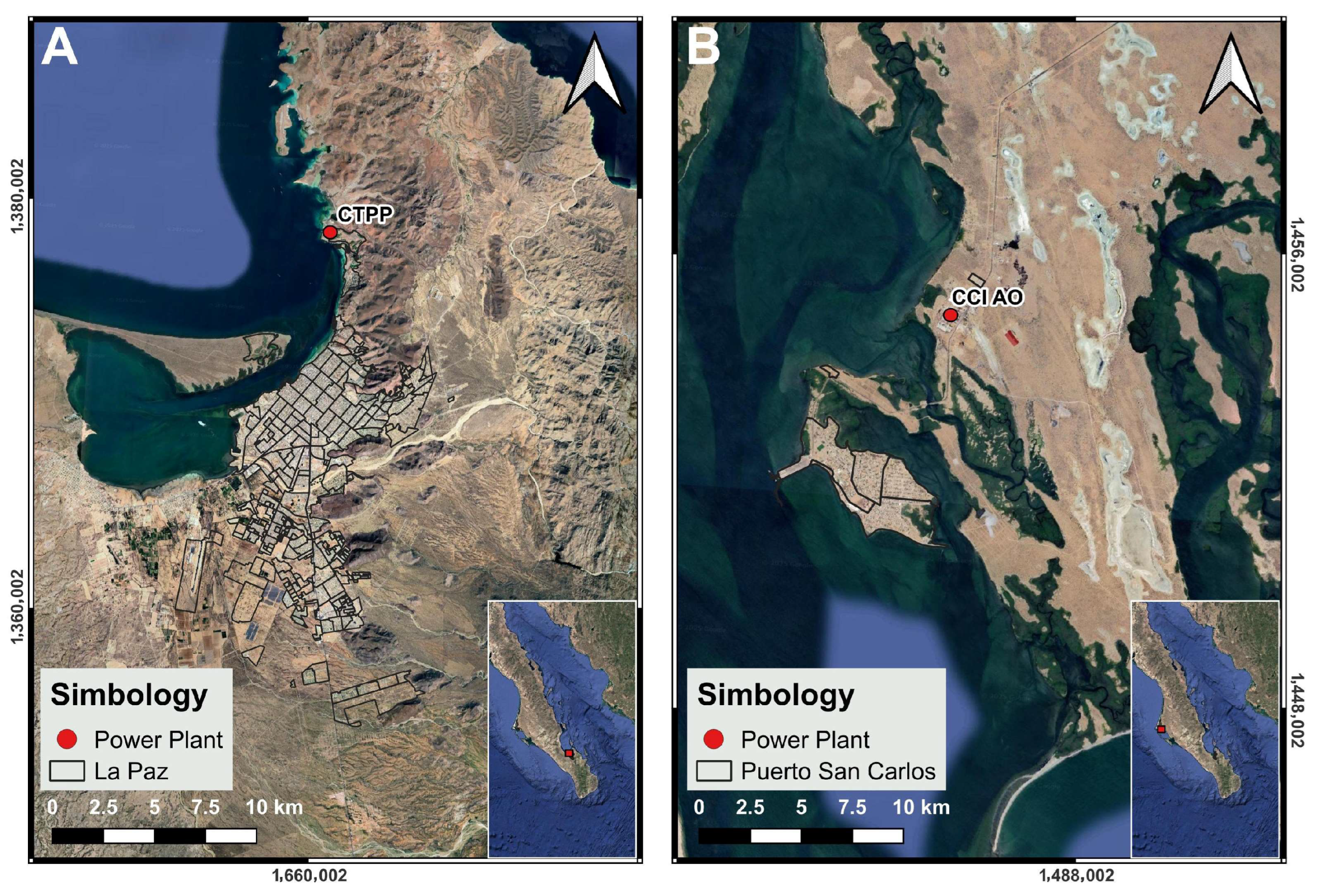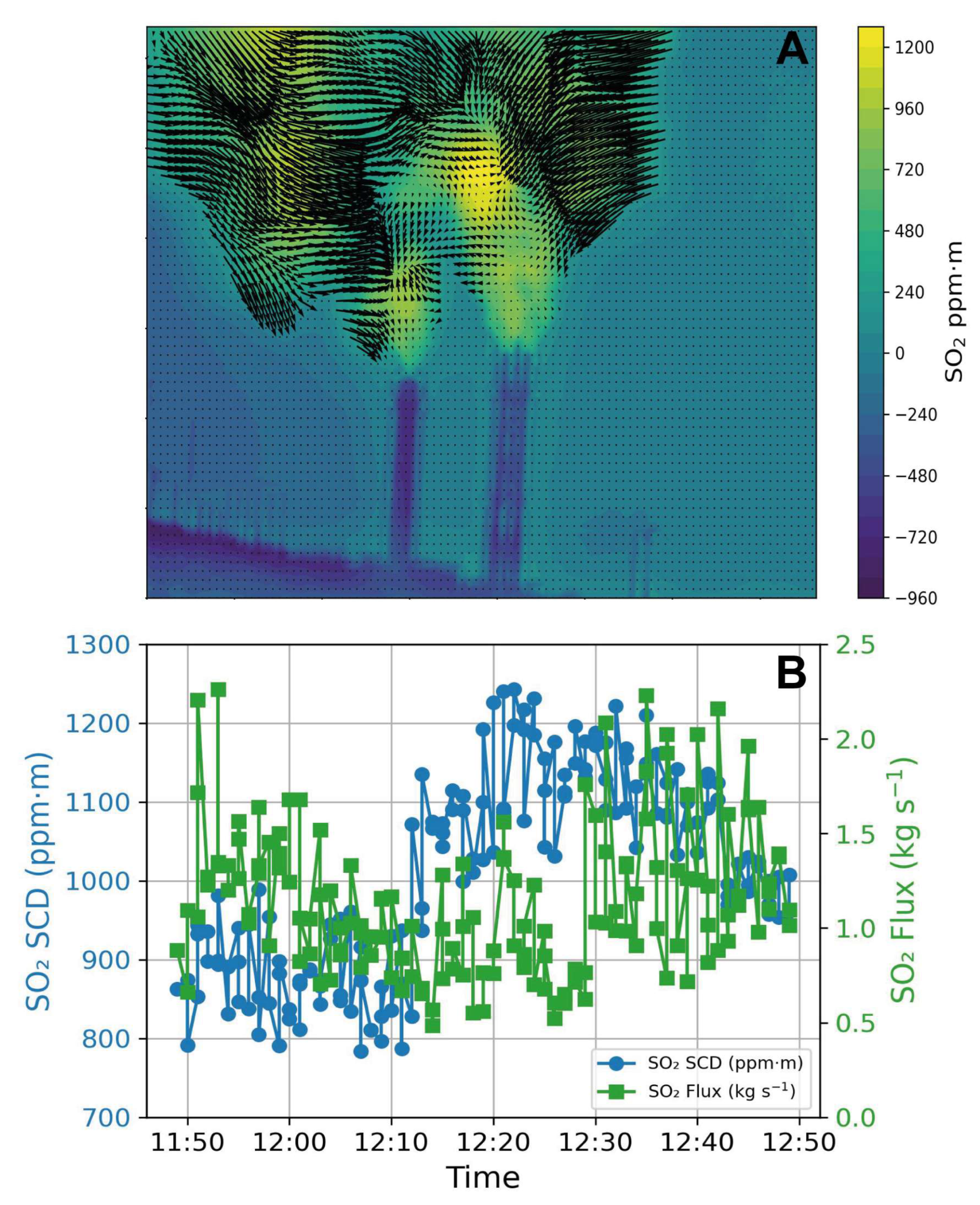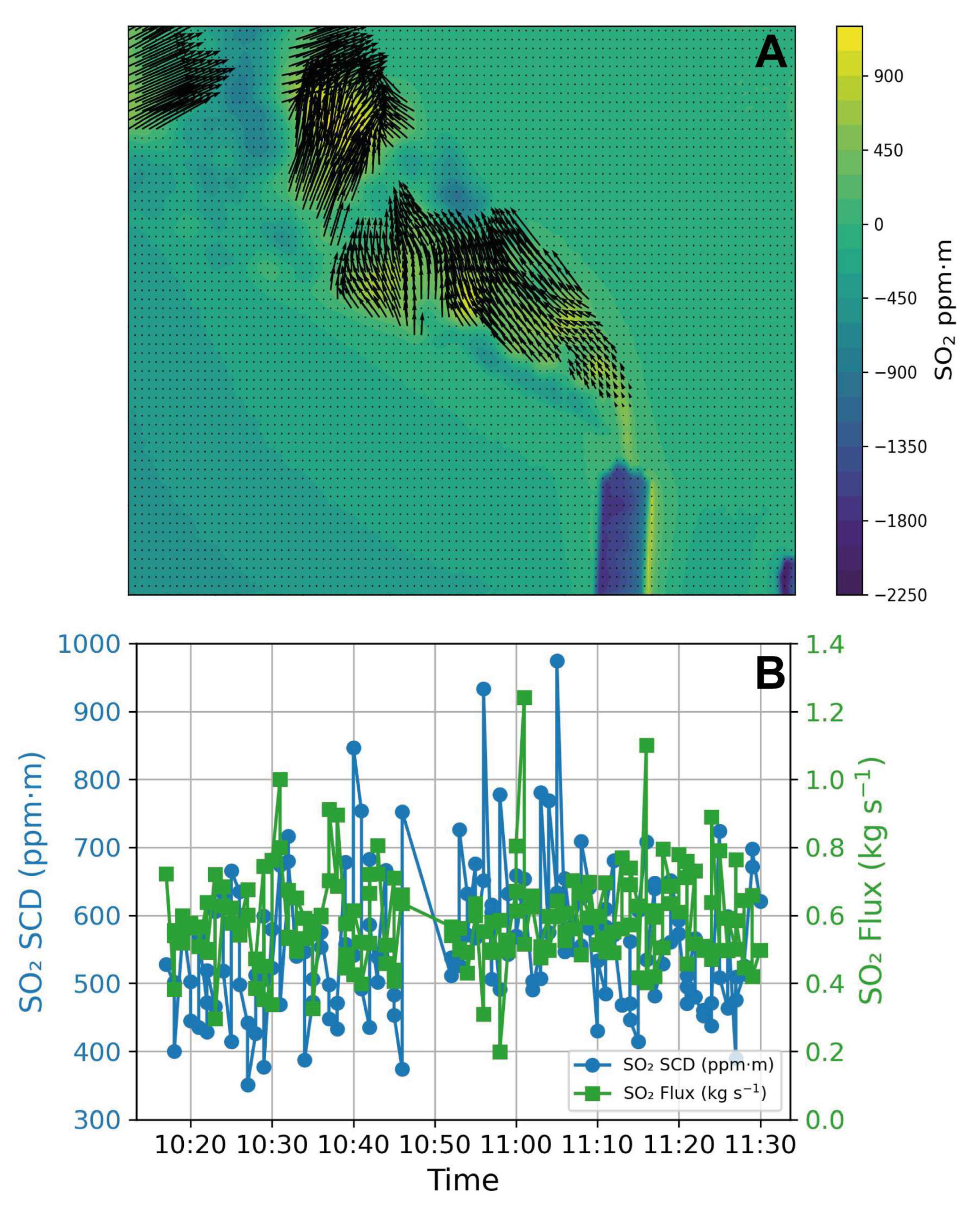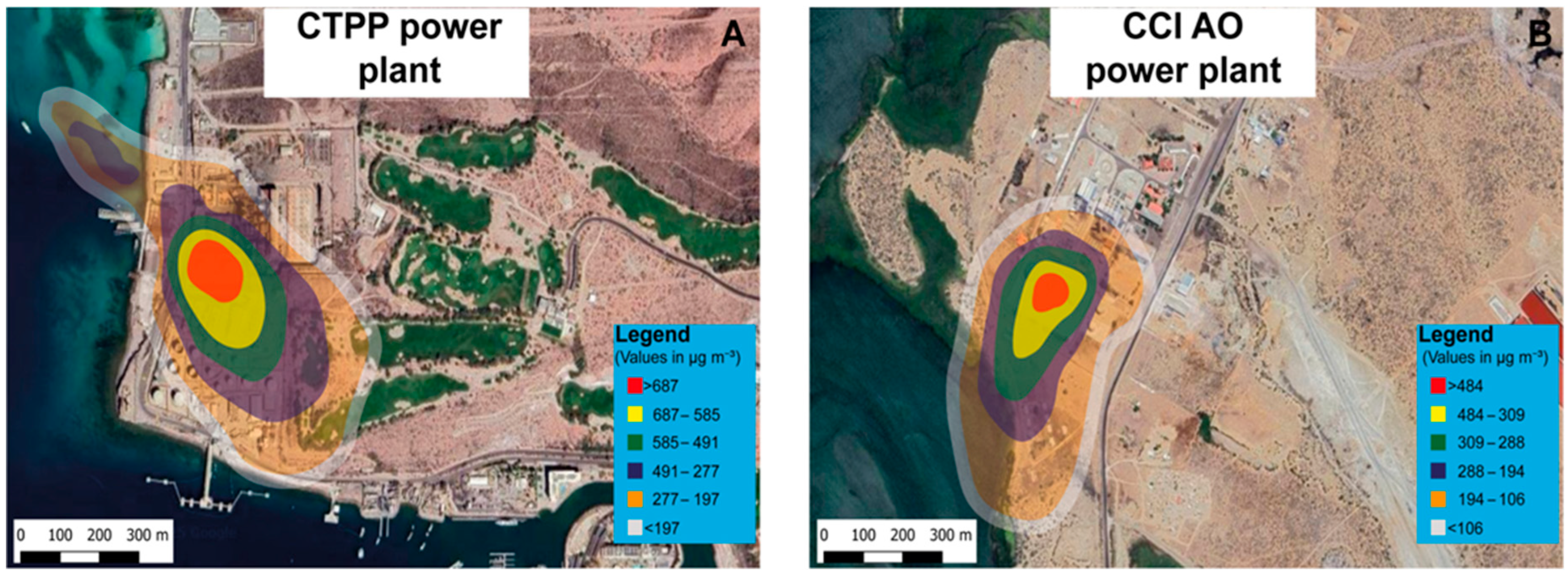Monitoring and Dispersion of SO2 Emissions from Power Plants Using UV Camera and AERMOD: A Case Study of Baja California Sur, Mexico
Abstract
1. Introduction
2. Materials and Methods
2.1. Study Area and Field Campaign
2.2. Emission Inventory of Power Plants
2.3. UV Camera
2.4. Error Analysis
2.5. Air Dispersion Modeling
3. Results
3.1. Descriptive Statistics of SO2 Emissions
3.2. CTPP Power Plant
3.3. CCI AO Power Plant
3.4. SO2 Dispersion Modeling
4. Discussion
5. Conclusions
Author Contributions
Funding
Institutional Review Board Statement
Informed Consent Statement
Data Availability Statement
Acknowledgments
Conflicts of Interest
References
- Sicard, P.; Agathokleous, E.; Anenberg, S.C.; De Marco, A.; Paoletti, E.; Calatayud, V. Trends in urban air pollution over the last two decades: A global perspective. Sci. Total Environ. 2023, 858, 160064. [Google Scholar] [CrossRef]
- Lin, Y.; Zhao, Y.; Zhang, Y.; Hong, Y.; Hattori, S.; Itahashi, S.; Fan, M.; Xie, F.; Zhao, Z.; Yu, M.; et al. China’s SO2 Emission Reductions Enhance Atmospheric Ozone—Driven Sulfate Aerosol Production in East Asia. Proc. Natl. Acad. Sci. USA 2025, 122, e2414064122. [Google Scholar] [CrossRef]
- Guttikunda, S.K.; Jawahar, P. Atmospheric emissions and pollution from the coal-fired thermal power plants in India. Atmos. Environ. 2014, 92, 449–460. [Google Scholar] [CrossRef]
- Zhao, X.; Shen, Z.; Han, F.; Bharti, B.; Feng, S.; Du, J.; Li, Y. Pollution Characteristics and Health Risk Assessment of Heavy Metals in PM2.5 in Fuxin, China. Environ. Geochem. Health 2024, 46, 511. [Google Scholar] [CrossRef]
- Xue, W.; Wang, L.; Li, X.; Xu, Q.; Yang, Z. The Impacts of Heat-Power Cogeneration on Air Pollution: An Empirical Study Based on the Measures for the Administration of Heat-Power Cogeneration Policy in China. J. Clean. Prod. 2025, 486, 144472. [Google Scholar] [CrossRef]
- WHO. WHO Global Air Quality Guidelines: Particulate Matter, Ozone, Nitrogen Dioxide, Sulfur Dioxide and Carbon Monoxide; World Health Organization: Geneva, Switzerland, 2021; Available online: https://www.who.int/publications/i/item/9789240034228 (accessed on 1 August 2025).
- Amann, M.; Klimont, Z.; Wagner, F. Regional and global emissions of air pollutants: Recent trends and future scenarios. Annu. Rev. Environ. Resour. 2013, 38, 31–55. [Google Scholar] [CrossRef]
- Schraufnagel, D.E.; Balmes, J.R.; Cowl, C.T.; Matteis, S.D.; Jung, S.H.; Mortimer, K.; Perez-Padilla, R.; Rice, M.B.; Riojas-Rodriguez, H.; Sood, A.; et al. Air pollution and noncommunicable diseases: A review by the Forum of International Respiratory Societies’ Environmental Committee. Chest 2019, 155, 409–416. [Google Scholar] [CrossRef] [PubMed]
- Pope, C.A.; Turner, M.C.; Burnett, R.T.; Jerrett, M.; Gapstur, S.M.; Diver, W.R.; Krewski, D.; Brook, R.D.; Arden Pope, C. Relationships between fine particulate air pollution, cardiometabolic disorders, and cardiovascular mortality. Circ. Res. 2018, 122, 1570–1595. [Google Scholar] [CrossRef] [PubMed]
- Likens, G.E.; Driscoll, C.T.; Buso, D.C. Long-term effects of acid rain: Response and recovery of a forest ecosystem. Environ. Pollut. 2022, 300, 118983. [Google Scholar] [CrossRef]
- Myhre, G.; Shindell, D.; Breon, F.M.; Collins, W.; Fuglestvedt, J.; Huang, J.; Koch, D.; Lamarque, J.F.; Lee, D.; Mendoza, B.; et al. Anthropogenic and natural radiative forcing. In Climate Change 2013: The Physical Science Basis. Contribution of Working Group I to the Fifth Assessment Report of the Intergovernmental Panel on Climate Change (IPCC AR5); Cambridge University Press: Cambridge, UK, 2013. [Google Scholar] [CrossRef]
- Fioletov, V.E.; McLinden, C.A.; Krotkov, N.; Li, C. Lifetimes and emissions of SO2 from point sources estimated from OMI. Geophys. Res. Lett. 2015, 42, 1969–1976. [Google Scholar] [CrossRef]
- Carn, S.A.; Fioletov, V.E.; McLinden, C.A.; Li, C.; Krotkov, N.A. A decade of global volcanic SO2 emissions measured from space. Sci. Rep. 2017, 7, 44095. [Google Scholar] [CrossRef]
- Chen, X.; Yang, T.; Wang, Z.; Hao, Y.; He, L.; Sun, H. Investigating the Impacts of Coal-Fired Power Plants on Ambient PM2.5 by a Combination of a Chemical Transport Model and Receptor Model. Sci. Total Environ. 2020, 727, 138407. [Google Scholar] [CrossRef]
- Kim, J.; Lee, G.; Jun, J.; Seo, B.-K.; Choi, Y. Quantification of SO2 and CO2 Emission Rates from Coal-Fired Power Plants in the Korean Peninsula via Airborne Measurements. Sci. Total Environ. 2025, 978, 179430. [Google Scholar] [CrossRef]
- Schaap, M.; Timmermans, R.M.A.; Roemer, M.; Boersen, G.A.C.; Builtjes, P.J.H.; Sauter, F.J.; Velders, G.J.M.; Beck, J.P. The LOTOS–EUROS Model: Description, Validation and Latest Developments. Int. J. Environ. Pollut. 2008, 32, 2. [Google Scholar] [CrossRef]
- Cimorelli, A.J.; Perry, S.G.; Venkatram, A.; Weil, J.C.; Paine, R.J.; Wilson, R.B.; Lee, R.F.; Peters, W.D. AERMOD: A dispersion model for industrial source applications. Part I: General model formulation and boundary layer characterization. J. Appl. Meteorol. 2005, 44, 682–693. [Google Scholar] [CrossRef]
- INEGI. Principales Resultados del Censo de Población y Vivienda 2020: Baja California Sur; INEGI: Aguascalientes, México, 2023; Available online: https://www.inegi.org.mx/contenidos/productos/prod_serv/contenidos/espanol/bvinegi/productos/nueva_estruc/702825198091.pdf (accessed on 1 August 2025).
- INEGI. Compendio de Información Geográfica Municipal 2010: La Paz, Baja California Sur; INEGI: Aguascalientes, México, 2010; Available online: https://www.inegi.org.mx/contenidos/app/mexicocifras/datos_geograficos/03/03003.pdf (accessed on 1 August 2025).
- García, J.A. Ambientes geológicos costeros del litoral de la Bahía de La Paz, Baja California Sur, México. CICIMAR—Instituto Politécnico Nacional, 2009. Available online: https://repositorioslatinoamericanos.uchile.cl/handle/2250/2885887?show=full (accessed on 18 June 2025).
- Bermúdez, C.A.; Ivanova Boncheva, A.; de la Peña Barron, A.; Bermúdez, A.; Casillas, E.; Landa, P.; Pérez, Y.; Lucero, B. Inventario de emisiones para la ciudad de La Paz, Baja California Sur. Centro de Energía Renovable y Calidad Ambiental (CERCA), 2016. Available online: https://www.cerca.org.mx/wp-content/uploads/2017/10/Inventario-de-emisiones-La-Paz-Informe-final.pdf (accessed on 1 August 2025).
- Comisión Federal de Electricidad (CFE). Cédula de Operación Anual Central Diesel Gral. Agustín Olachea Avilés 2013. Comisión Federal de Electricidad, 2013. Available online: https://cerca.org.mx/wp-content/uploads/2023/05/COA-GAO-2013.-AGUSTINOLACHEA-2013.pdf (accessed on 1 August 2025).
- Rivera-Cárdenas, C.I.; Barrera-Huertas, H.A.; Valenzuela, J.; Rangel, R.; López-Zamudio, E.; Carbajal-Aguilar, C.C. Emissions to the atmosphere by power plants in Baja California Sur, Mexico. Renew. Energy Biomass Sustain. 2024, 6, 28–42. [Google Scholar] [CrossRef]
- Comisión Federal de Electricidad (CFE). SO2 emissions reported in the Cédula de Operación Anual for the Gral. Agustín Olachea Avilés Diesel Power Plant, 2010. Comisión Federal de Electricidad, 2010. Available online: https://cerca.org.mx/wp-content/uploads/2023/05/COA-GAO-2010.-AGUSTINOLACHEA-2010.pdf (accessed on 1 August 2025).
- Comisión Federal de Electricidad (CFE). Cédula de Operación Anual C.D.E. Gral. Agustín Olachea Avilés 2014. Comisión Federal de Electricidad, 2014. Available online: https://cerca.org.mx/wp-content/uploads/2023/05/COA-GAO-2014.-AGUSTINOLACHEA-2014.pdf (accessed on 30 November 2023).
- Comisión Federal de Electricidad (CFE). Cédula de Operación Anual Central de Combustión Interna Baja California Sur 2018. Comisión Federal de Electricidad, 2018a. Available online: https://cerca.org.mx/wp-content/uploads/2023/05/COA-CCIBCS-2018-PUBLICA.pdf (accessed on 1 August 2025).
- Comisión Federal de Electricidad (CFE). Cédula de Operación Anual C.D.E. Gral. Agustín Olachea Avilés 2018. Comisión Federal de Electricidad, 2018b. Available online: https://cerca.org.mx/wp-content/uploads/2023/05/COA-2018-GAO-Testada-pdf.pdf (accessed on 1 August 2025).
- Comisión Federal de Electricidad (CFE). Cédula de Operación Anual Central de Combustión Interna Baja California Sur 2019. Comisión Federal de Electricidad, 2019a. Available online: https://cerca.org.mx/wp-content/uploads/2023/05/COA-2019-CCIBCS-Publica.pdf (accessed on 1 August 2025).
- Comisión Federal de Electricidad (CFE). Cédula de Operación Anual C.D.E. Gral. Agustín Olachea Avilés 2019. Comisión Federal de Electricidad, 2019b. Available online: https://cerca.org.mx/wp-content/uploads/2023/05/COA-2019-PUBLICA-v1.pdf (accessed on 1 August 2025).
- Comisión Federal de Electricidad (CFE). Cédula de Operación Anual Central Termoeléctrica Punta Prieta y Turbo Gas La Paz 2019. Comisión Federal de Electricidad, 2019c. Available online: https://cerca.org.mx/wp-content/uploads/2023/05/COA-2019-CT-PUNTA-PRIETA-PUBLICA.pdf (accessed on 1 August 2025).
- Comisión Federal de Electricidad (CFE). Cédula de Operación Anual Central de Combustión Interna Baja California Sur 2020. Comisión Federal de Electricidad, 2020a. Available online: https://cerca.org.mx/wp-content/uploads/2023/05/COA-2020-CCIBCS-Publica-V2.pdf (accessed on 1 August 2025).
- Comisión Federal de Electricidad (CFE). Cédula de Operación Anual C.D.E. Gral. Agustín Olachea Avilés 2020. Comisión Federal de Electricidad, 2020b. Available online: https://cerca.org.mx/wp-content/uploads/2023/05/COA-2020-PUBLICA-v1.pdf (accessed on 1 August 2025).
- Comisión Federal de Electricidad (CFE). Cédula de Operación Anual Central Termoeléctrica Punta Prieta y Turbo Gas La Paz 2020. Comisión Federal de Electricidad, 2020c. Available online: https://cerca.org.mx/wp-content/uploads/2023/05/COA-2018-CT-PUNTA-PRIETA-TESTADO-v1.pdf (accessed on 1 August 2025).
- Comisión Federal de Electricidad (CFE). Cédula de Operación Anual C.C.I. Gral. Agustín Olachea Avilés 2021. Comisión Federal de Electricidad, 2021a. Available online: https://cerca.org.mx/wp-content/uploads/2023/05/COA-2021-Agustin-OlacheaPUBLICA.pdf (accessed on 1 August 2025).
- Comisión Federal de Electricidad (CFE). Cédula de Operación Anual Central de Combustión Interna Baja California Sur 2021. Comisión Federal de Electricidad, 2021b. Available online: https://cerca.org.mx/wp-content/uploads/2023/05/COA-CCI-La-Paz-2021.pdf (accessed on 1 August 2025).
- Farneback, G. Two-Frame Motion Estimation Based on Polynomial Expansion. In Image Analysis: SCIA 2003; Bigun, J., Gustavsson, T., Eds.; Springer: Berlin/Heidelberg, Germany, 2003; Volume 2749, pp. 363–370. [Google Scholar] [CrossRef]
- Schiavo, B.; Stremme, W.; Grutter, M.; Campion, R.; Guarin, C.A.; Rivera, C.; Inguaggiato, S. Characterization of a UV Camera System for SO2 Measurements from Popocatépetl Volcano. J. Volcanol. Geotherm. Res. 2019, 370, 82–94. [Google Scholar] [CrossRef]
- Dalton, M.P.; Watson, I.M.; Nadeau, P.A.; Werner, C.; Morrow, W.; Shannon, J.M. Assessment of the UV Camera Sulfur Dioxide Retrieval for Point Source Plumes. J. Volcanol. Geotherm. Res. 2009, 188, 358–366. [Google Scholar] [CrossRef]
- Kern, C.; Kick, F.; Lübcke, P.; Vogel, L.; Wöhrbach, M.; Platt, U. Theoretical description of functionality, applications, and limitations of SO2 cameras for the remote sensing of volcanic plumes. Atmos. Meas. Tech. 2010, 3, 733–749. [Google Scholar] [CrossRef]
- Mori, T.; Burton, M. The SO2 camera: A simple, fast and cheap method for ground-based imaging of SO2 in volcanic plumes. Geophys. Res. Lett. 2006, 33, L24804. [Google Scholar] [CrossRef]
- Vita, F.; Schiavo, B.; Inguaggiato, C.; Inguaggiato, S.; Mazot, A. Environmental and Volcanic Implications of Volatile Output in the Atmosphere of Vulcano Island Detected Using SO2 Plume (2021–2023). Remote Sens. 2023, 15, 3086. [Google Scholar] [CrossRef]
- Cimorelli, A.J.; Perry, S.G.; Venkatram, A.; Weil, J.C.; Paine, R.J.; Wilson, R.B.; Lee, R.F.; Peters, W.D.; Paumier, J.O. AERMOD: Description of Model Formulation; U.S. Environmental Protection Agency Report; EPA 2003 454/R,03,002d; U.S. EPA: Washington, DC, USA, 2003; 85p. Available online: https://gaftp.epa.gov/Air/aqmg/SCRAM/models/preferred/aermod/aermod_mfd_454-R-03-004.pdf (accessed on 1 August 2025).
- Vita, F.; Schiavo, B.; Inguaggiato, C.; Cabassi, J.; Venturi, S.; Tassi, F.; Inguaggiato, S. Output of Volcanic SO2 Gases and Their Dispersion in the Atmosphere: The Case of Vulcano Island, Aeolian Archipelago, Italy. Atmosphere 2025, 16, 651. [Google Scholar] [CrossRef]
- Frins, E.; Ibrahim, O.; Casaballe, N.; Osorio, M.; Arismendi, F.; Wagner, T.; Platt, U. Ground Based Measurements of SO2 and NO2 Emissions from the Oil Refinery “La Teja” in Montevideo City. J. Phys. Conf. Ser. 2011, 274, 012083. [Google Scholar] [CrossRef]
- Andri, B.H.; Basuki, E.S.; Seputro, E.; Kusuma, E. Efforts to Reduce SO2 Emission in Paiton Coal-Fired Power Plant. IOP Conf. Ser. Mater. Sci. Eng. 2021, 1096, 012125. [Google Scholar] [CrossRef]
- Nisulescu, G.C.; Ionel, I.; Malan, B.; Dobrin, M. Remote SO2 Monitoring with UV Cameras for Stack Emissions. Rev. Chim. 2012, 63, 940–944. [Google Scholar] [CrossRef]
- Tan, W.; Liu, C.; Wang, S.; Liu, H.; Zhu, Y.; Su, W.; Hu, Q.; Liu, J. Long-Distance Mobile MAX-DOAS Observations of NO2 and SO2 over the North China Plain and Identification of Regional Transport and Power Plant Emissions. Atmos. Res. 2020, 245, 105037. [Google Scholar] [CrossRef]
- Ramadan, A.A.; Al-Sudairawi, M.; Alhajraf, S.; Khan, A.R. Total SO2 Emissions from Power Stations and Evaluation of Their Impact in Kuwait Using a Gaussian Plume Dispersion Model. Am. J. Environ. Sci. 2008, 4, 1–12. [Google Scholar] [CrossRef]
- Zhang, Y.G.; Wang, H.S.; Somesfalean, G.; Wang, Z.Y.; Lou, X.T.; Wu, S.H.; Zhang, Z.G.; Qin, Y.K. Broadband UV Spectroscopy System Used for Monitoring of SO2 and NO Emissions from Thermal Power Plants. Atmos. Environ. 2010, 44, 4266–4271. [Google Scholar] [CrossRef]
- González Rivero, R.A.; Rivera Cárdenas, C.I.; Barrera Huertas, H.A.; Trueba Vázquez, M. Assessment of NO2 and SO2 Emissions in the Tula Industrial Complex, Hidalgo, Using the Mobile Mini-DOAS Technique Combined with the AERMOD Dispersion Model. Environ. Monit. Assess. 2025, 197, 864. [Google Scholar] [CrossRef]
- Prata, A.J. Measuring SO2 Ship Emissions with an Ultraviolet Imaging Camera. Atmos. Meas. Tech. 2014, 7, 1213–1229. [Google Scholar] [CrossRef]
- Gliß, J.; Stebel, K.; Kylling, A.; Sudbø, A. Improved Optical Flow Velocity Analysis in SO2 Camera Images of Volcanic Plumes—Implications for Emission-Rate Retrievals Investigated at Mt Etna, Italy and Guallatiri, Chile. Atmos. Meas. Tech. 2018, 11, 781–801. [Google Scholar] [CrossRef]
- Lo Bue Trisciuzzi, G.; Aiuppa, A.; Salerno, G.; Bitetto, M.; Curcio, L.; Innocenti, L.; Lacanna, G.; Nogueira Lages, J.P.; Lo Forte, F.M.; Maugeri, S.R.; et al. Improved Volcanic SO2 Flux Records from Integrated Scanning-DOAS and UV Camera Observations. J. Volcanol. Geotherm. Res. 2024, 455, 108207. [Google Scholar] [CrossRef]
- Nurhisanah, S.; Hasyim, H. Environmental Health Risk Assessment of Sulfur Dioxide (SO2) at Workers around in Combined Cycle Power Plant (CCPP). Heliyon 2022, 8, e09388. [Google Scholar] [CrossRef] [PubMed]
- Norma Oficial Mexicana (NOM-022-SSA1-2019). Salud Ambiental. Criterios para evaluar la calidad del aire; Secretaría de Salud: México City, México. 2019. Available online: https://www.dof.gob.mx/nota_detalle.php?codigo=5568395&fecha=20/08/2019#gsc.tab=0 (accessed on 1 August 2025).




| Power Plants | SO2 | NOx | CO | PM10 | PM2.5 | VOC |
|---|---|---|---|---|---|---|
| CTPP a | 2428.1 | 987.4 | 108.7 | 30.8 | 266.3 | 16.2 |
| CCI BCS a | 11,916.4 | 11,439.3 | 2473.1 | 808.4 | 17.5 | 0 |
| CCI AO b | 4913.2 | 3930.3 | nd | 99 | 99 | nd |
| Year | CTPP | CCI BCS | CCI AO | Source | Reference |
|---|---|---|---|---|---|
| 2010 | nd | nd | 16,028.89 | COAs | CFE, [24] |
| 2013 | 2428.1 | 11,916.43 | 8704.90 | COAs | Bermúdez et al. [21]; CFE, [22] |
| 2014 | nd | nd | 6786.13 | COAs | CFE, [25] |
| 2018 | nd | 17,183.73 | 7988.00 | COAs | CFE, [26,27] |
| 2019 | 14,033.5 | 15,359.78 | 6431.64 | COAs | CFE, [28,29,30] |
| 2020 | 13,628.9 | 17,649.01 | 6490.20 | COAs | CFE, [31,32,33] |
| 2021 | nd | 14,398.96 | 4913.19 | COAs | CFE, [34,35] |
| 2022 | 23,970.6 | 16,322.60 | 6633.84 | Mini-DOAS | Rivera-Cárdenas et al. [23] |
| Instrument | Parameters | ||||
|---|---|---|---|---|---|
| Focal length (mm) | Measurement range (nm) | CCD | Lens diameter (mm) | Image resolution | |
| UV camera | 50 | from 300 to 450 | KAF-1603ME (1.6 MP) | 25 | 1536 × 1024 |
| CTPP | CCI AO | ||
|---|---|---|---|
| SCD (ppm·m) | Mean (min–max) | 1009.2 (784.1–1242.8) | 559.4 (350.5–974.5) |
| Median | 1020.1 | 549.3 | |
| SD | 125.9 | 103.1 | |
| Flux (kg s−1) | Mean (min–max) | 1.13 (0.49–2.26) | 0.59 (0.20–1.24) |
| Median | 1.06 | 0.57 | |
| SD | 0.39 | 0.14 | |
| Wind Speed (m s−1) | Mean | 3.6 | 2.2 |
| Site | Plant Type/Fuel | Power (MW) | SO2 SCD * (ppm·m) | SO2 Flux (kg s−1) | Reference |
|---|---|---|---|---|---|
| CTPP | Fuel oil | 155 | 1009.2 | 1.13 | This work |
| CCI AO | Fuel oil | 77.6 | 559.4 | 0.59 | This work |
| Montevideo, Uruguay | Fuel oil | nr | nr | 0.32 | Frins et al. [44] |
| Bucharest, Rumania | Coal | nr | 715 | 1.27 | Nisulescu et al. [46] |
| Dezhou, China | Coal | 2670 | nr | 1.11 | Tan et al. [47] |
| Doha, Kuwait | Fuel oil | nr | 1.29 | Ramadan et al. [48] | |
| Shandong, China | Coal | 50 | nr | 0.09 | Zhang et al. [49] |
| Tula, Mexico | Fuel oil | 1605 | nr | 4.28 | González-Rivero et al. [50] |
Disclaimer/Publisher’s Note: The statements, opinions and data contained in all publications are solely those of the individual author(s) and contributor(s) and not of MDPI and/or the editor(s). MDPI and/or the editor(s) disclaim responsibility for any injury to people or property resulting from any ideas, methods, instructions or products referred to in the content. |
© 2025 by the authors. Licensee MDPI, Basel, Switzerland. This article is an open access article distributed under the terms and conditions of the Creative Commons Attribution (CC BY) license (https://creativecommons.org/licenses/by/4.0/).
Share and Cite
Schiavo, B.; Stremme, W.; Meza, J.V.; Rangel-Rodríguez, R.; Carbajal-Aguilar, C.C.; Ortega-Flores, P.A. Monitoring and Dispersion of SO2 Emissions from Power Plants Using UV Camera and AERMOD: A Case Study of Baja California Sur, Mexico. Atmosphere 2025, 16, 1128. https://doi.org/10.3390/atmos16101128
Schiavo B, Stremme W, Meza JV, Rangel-Rodríguez R, Carbajal-Aguilar CC, Ortega-Flores PA. Monitoring and Dispersion of SO2 Emissions from Power Plants Using UV Camera and AERMOD: A Case Study of Baja California Sur, Mexico. Atmosphere. 2025; 16(10):1128. https://doi.org/10.3390/atmos16101128
Chicago/Turabian StyleSchiavo, Benedetto, Wolfgang Stremme, Jaqueline Valenzuela Meza, Rodrigo Rangel-Rodríguez, Cristina Carolina Carbajal-Aguilar, and Paulina Annette Ortega-Flores. 2025. "Monitoring and Dispersion of SO2 Emissions from Power Plants Using UV Camera and AERMOD: A Case Study of Baja California Sur, Mexico" Atmosphere 16, no. 10: 1128. https://doi.org/10.3390/atmos16101128
APA StyleSchiavo, B., Stremme, W., Meza, J. V., Rangel-Rodríguez, R., Carbajal-Aguilar, C. C., & Ortega-Flores, P. A. (2025). Monitoring and Dispersion of SO2 Emissions from Power Plants Using UV Camera and AERMOD: A Case Study of Baja California Sur, Mexico. Atmosphere, 16(10), 1128. https://doi.org/10.3390/atmos16101128






